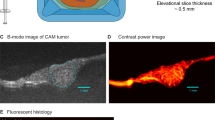Abstract
Zebrafish are a valuable vertebrate model to study carcinogenesis, but noninvasive imaging is challenging because adult fish are not transparent. Here we show that tumors could be readily detected in vivo using high-resolution microscopic ultrasound in zebrafish. We successfully obtained tissue perfusion calculations and cellular aspirates, and analyzed tumor progression and response to treatment. Ultrasound biomicroscopy allows longitudinal studies of tumor development and real-time assessment of therapeutic effects in zebrafish.
This is a preview of subscription content, access via your institution
Access options
Subscribe to this journal
Receive 12 print issues and online access
$259.00 per year
only $21.58 per issue
Buy this article
- Purchase on Springer Link
- Instant access to full article PDF
Prices may be subject to local taxes which are calculated during checkout



Similar content being viewed by others
References
Goessling, W., North, T.E. & Zon, L.I. J. Clin. Oncol. (in the press).
Lam, S.H. et al. Nat. Biotechnol. 24, 73–75 (2006).
Berghmans, S. et al. Proc. Natl. Acad. Sci. USA 102, 407–412 (2005).
Patton, E.E. et al. Curr. Biol. 15, 249–254 (2005).
Schnall, M. & Rosen, M. J. Clin. Oncol. 24, 3225–3233 (2006).
Goertz, D.E., Yu, J.L., Kerbel, R.S., Burns, P.N. & Foster, F.S. Cancer Res. 62, 6371–6375 (2002).
Foster, F.S., Pavlin, C.J., Harasiewicz, K.A., Christopher, D.A. & Turnbull, D.H. Ultrasound Med. Biol. 26, 1–27 (2000).
Goertz, D.E., Yu, J.L., Kerbel, R.S., Burns, P.N. & Foster, F.S. Ultrasound Med. Biol. 29, 39–51 (2003).
Goertz, D.E., Frijlink, M.E., de Jong, N. & van der Steen, A.F. Ultrasound Med. Biol. 32, 569–577 (2006).
Lindner, J.R. Nat. Rev. Drug Discov. 3, 527–532 (2004).
Jouannot, E. et al. Ultrasound Med. Biol. 32, 183–190 (2006).
Franco, M. et al. Cancer Res. 66, 3639–3648 (2006).
Acknowledgements
We thank T. Coulthard and T. Potdevin at VisualSonics for their assistance with microbubble and power Doppler analyses, respectively. Histology services were provided by J. Williams and J. Kutok at the Hematopathology Core Lab of the Dana-Farber/Harvard Cancer Center. We thank J. Glickman (Department of Pathology, Brigham and Women's Hospital) for assistance with histopathological analysis. This research was supported by a Friends of Dana-Farber fellowship (W.G.), an American Gastroenterological Association/AstraZeneca Fellowship-Faculty Transition Award (W.G.), US National Institute of Diabetes and Digestive and Kidney Diseases 5 K08 DK 071940-02 (W.G.), The American Cancer Society (T.E.N.), US National Institutes of Health (L.I.Z.) and Howard Hughes Medical Institute (L.I.Z.).
Author information
Authors and Affiliations
Contributions
W.G. and T.E.N. conducted all ultrasound analyses, histopathological examinations and chemical treatments described. W.G., T.E.N. and L.I.Z. wrote the manuscript.
Corresponding author
Ethics declarations
Competing interests
The authors declare no competing financial interests.
Supplementary information
Supplementary Text and Figures
Supplementary Figures 1–3, Supplementary Tables 1–2, Supplementary Methods. (PDF 592 kb)
Supplementary Movie 1
Animation of 3D image reconstruction. The fish shown in Figures 3a-d underwent serial ultrasound imaging. 3D reconstruction of the fish was performed using the ultrasound software, and the volumes of both the entire tumor and a cyst within the tumor were determined (tumor volume shown in blue, cyst volume shown in red). Free rotation of the 3D reconstruction enables the assessment of tissue relationships from different angles. (MOV 1983 kb)
Supplementary Movie 2
Pulsewave Doppler analysis of a tumor vessel. The fish shown in Figures 3a-d and Supplementary Movie 1 underwent pulsewave Doppler analysis of a blood vessel feeding the tumor. The vessel analyzed is bracketed by red parallel lines (right center panel), and the corresponding Doppler pulsewave is shown (lower panel). (MOV 1528 kb)
Supplementary Movie 3
Microbubble contrast demonstrates tumor perfusion. A microbubble suspension was injected directly into the zebrafish heart. The enhanced contrast caused by the microbubbles is colored in green. A brief ultrasound pulse leads to destruction of the bubbles in the target area (indicated by red bars in the movie timeline) and subsequent ablation of the signal. The contrast re-emerges over time and allows calculation of perfusion velocity rates as depicted in Figure 3h. (MOV 1469 kb)
Supplementary Movie 4
Ultrasound-guided aspiration of a liver tumor. A tumor-bearing fish was subjected to in vivo aspiration of a liver tumor using a micromanipulator and a syringe equipped with a 23-Gauge needle. The needle and tumor were positioned in the same ultrasound imaging plane to allow direct visualization during the aspiration. Aspirates were sufficient for cytological analysis and transplantation. 10/12 fish survived this procedure. (MOV 1039 kb)
Rights and permissions
About this article
Cite this article
Goessling, W., North, T. & Zon, L. Ultrasound biomicroscopy permits in vivo characterization of zebrafish liver tumors. Nat Methods 4, 551–553 (2007). https://doi.org/10.1038/nmeth1059
Received:
Accepted:
Published:
Issue Date:
DOI: https://doi.org/10.1038/nmeth1059
This article is cited by
-
In Vivo Modeling of Human Breast Cancer Using Cell Line and Patient-Derived Xenografts
Journal of Mammary Gland Biology and Neoplasia (2022)
-
Acoustofluidic rotational tweezing enables high-speed contactless morphological phenotyping of zebrafish larvae
Nature Communications (2021)
-
Intact in vivo visualization of telencephalic microvasculature in medaka using optical coherence tomography
Scientific Reports (2020)
-
In vivo longitudinal study of rodent skeletal muscle atrophy using ultrasonography
Scientific Reports (2016)
-
Zebrafish xenotransplantation as a tool for in vivo cancer study
Familial Cancer (2015)



